How Come the Epson V750 Pro Wont Scan Continuously Without Me Moving the Mouse
Selecting Epson Scan Settings
Overview of the Epson Scan Modes
Epson Scan lets you control all aspects of scanning and includes three modes.
Full Auto Mode lets you scan quickly and easily, without selecting any settings or previewing your image. This is the default mode in Epson Scan.
Full Auto Mode is best when you need to scan your images at 100% size and you do not need to preview the images before scanning. You can restore faded colors or remove dust marks by clicking the Customize button.
See Using Full Auto Mode for instructions on scanning in this mode.
 Note:
Note:
In Full Auto Mode, you can scan only 35mm color negative film strips or color positive slides. To scan other types of film, use Home or Professional Mode.
Home Mode lets you customize some scanning settings and check their effects with a preview image.
Home Mode is best when you want to preview images of photos, film, or slides before scanning them. You can size the image as you scan, adjust the scan area, and adjust many image settings, including color restoration, Digital ICE Technology (for color film and slides only), and backlight correction.
See Changing the Scan Mode for instructions on switching to Home Mode.
See Selecting Basic Settings for scanning steps.
Professional Mode gives you total control of your scanning settings and lets you check their effects with a preview image.
Professional Mode is best when you want to preview your image and make extensive, detailed corrections to it before scanning. You can sharpen, color correct, and enhance your image with a full array of tools, including color restoration, dust removal, Digital ICE Technology and Digital ICE Lite Technology (for color film and slides only), and backlight correction.
See Changing the Scan Mode for instructions on switching to Professional Mode.
See Selecting Basic Settings for scanning steps.
Selecting File Save Settings
When you see the File Save Settings window, you need to select the location, name, and format of the scanned image file you want to save.
 | Do one of the following to open the File Save Settings window. |
Full Auto Mode
In the Standby window, click the Customize button, then click the File Save Settings button. (If you started Epson Scan from a program like Adobe Photoshop Elements, this button doesn't appear.)
Home or Professional Mode
Click the  File Save Settings button to the right of the Scan button. (If you started Epson Scan from a program like Adobe Photoshop Elements, this button doesn't appear.)
File Save Settings button to the right of the Scan button. (If you started Epson Scan from a program like Adobe Photoshop Elements, this button doesn't appear.)
 | In the File Save Settings window, specify the file folder in which you want to save your scanned image. Click the Documents or Pictures radio button, or the My Documents or My Pictures radio button. |
If you want to select another folder, click Other, then click Browse (Windows) or Choose (Mac OS X) and select the folder. If you want to save your image on the desktop, simply click Other.
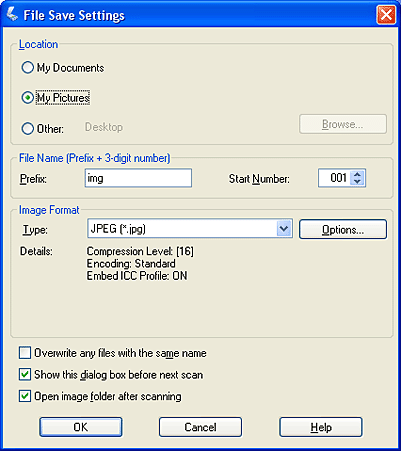
 | Specify a file name prefix with an alphanumeric character string. A 3-digit number is automatically added to the file name, but you can change the Start Number if you like. If you are scanning multiple images at once, each image will receive a different 3-digit number. |
 Note:
Note:
With Windows, the following characters cannot be used in the prefix.
\, /, :, ., *, ?, ", <, >, │
With Mac OS X, you cannot use a colon (:) in the prefix.
 | Select a file format as described in the following table. Depending on the format, the Options button may be available for making detailed settings. |
| Format (File Extension) | Explanation |
| BITMAP (*.BMP) (Windows only) | A standard image file format for Windows. Most Windows programs, including word processing programs, can read images in this format. |
| JPEG (*.JPG) | A compressed file format in which the compression level can be selected. The JPEG format lets you highly compress image data. However, the higher the compression, the lower the image quality. Any lost image quality data cannot be restored and the quality deteriorates each time the data is saved. The TIFF format is recommended when modification and retouching are required. |
| Multi-TIFF (*.TIF) | A TIFF format where multiple pages are saved to the same file. You can also edit the scanned images before saving them. See Epson Scan Help for details. To open Multi-TIFF files, you need a program that supports it. |
| PDF (*.PDF) | A document format that can be read on both Windows and Macintosh systems (platform independent). To use PDF documents in Windows, you need Adobe Reader or Acrobat. Multi-page documents can be saved as one PDF file. When you save color or grayscale images in PDF, you can select a compression level. You can also edit the scanned images before they are saved. See Scanning Directly to a PDF File for details. |
| PICT (*.PCT) (Macintosh only) | A standard image file format for Macintosh. Most Macintosh programs, including word processing programs, can read images in this format. |
| PRINT Image Matching II JPEG (*.JPG) or TIFF (*.TIF) | A file format that includes PRINT Image Matching II data for enhanced quality and a wider color range. Print Image Matching II compatible printers can then print this data for brilliant, true-to-life results. (PRINT Image Matching data does not affect the way the image displays on the screen.) Available in JPEG or TIFF format. |
| TIFF (*.TIF) | A file format created for exchanging data between many programs, such as graphic and DTP software. When scanning black & white images, you can specify the compression type. |
 | The checkboxes at the bottom of the window give you these options. |
Overwrite any files with the same name
Select this option if you want to reuse the selected file name and location and overwrite previous files with the same names.
Show this dialog box before next scan
Select this option if you want the File Save Settings window to appear automatically before you scan (Home or Professional Mode only). If you deselect it, you must click the  File Save Settings button to open the window in Home or Professional Mode.
File Save Settings button to open the window in Home or Professional Mode.
Open image folder after scanning
Select this option if you want Windows Explorer or the Macintosh Finder to automatically open the folder where your scanned image is saved when Epson Scan finishes scanning.
 | Click OK. |
 | In Full Auto Mode, click OK again, then click Scan. In Home or Professional Mode, click Preview, then click Scan. |
The scanned image is automatically saved in the file and location you chose.
Using Full Auto Mode
When you start Epson Scan for the first time, it runs in Full Auto Mode and displays the Epson Scan standby window.
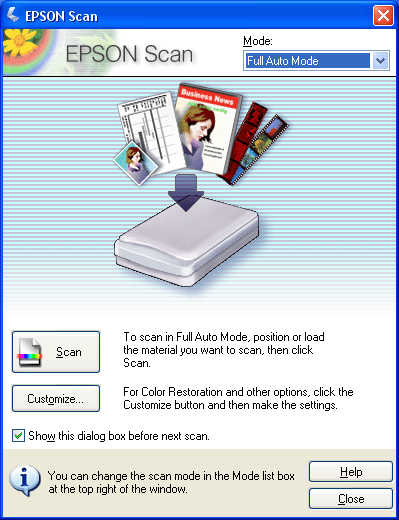
 Note:
Note:
In Full Auto Mode, you can scan only 35mm color negative film strips or color positive slides. To scan other types of film, use Home or Professional Mode.
 | If you want to select a custom resolution, restore faded colors, or remove dust marks, click the Customize button. You see the Customize window. |
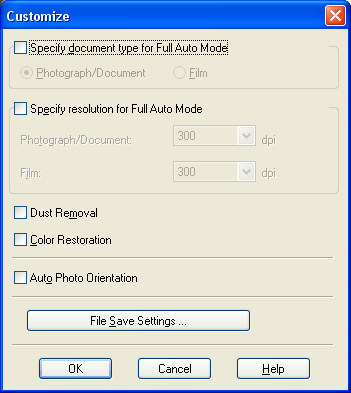
 Note:
Note:
If you started scanning from a program like Adobe Photoshop Elements, the File Save Settings button is not available in the Customize window.
Select your settings and click OK. (For details on selecting settings, click the Help button.)
 | Click the Scan button. Epson Scan starts scanning in Full Auto Mode. |
Epson Scan previews each image in your film strip or each slide, detects whether it is color positive or color negative, and selects the scan settings automatically. After a moment, you see a small preview of each image in the Epson Scan window. (It takes a few minutes to scan a full film strip.)
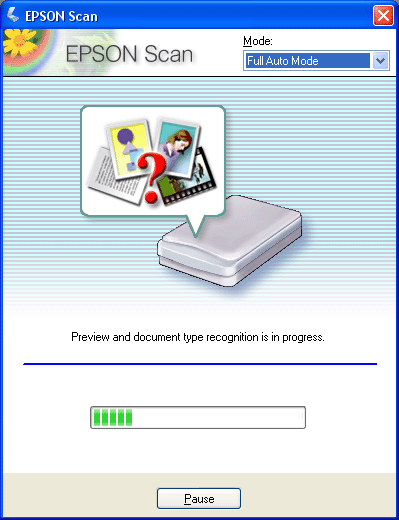
 Note:
Note:
If you need to change any settings, click the Pause button. You will return to the Epson Scan standby window.
If you need to cancel scanning, click the Cancel button when it appears.
 | Depending on how you started Epson Scan, the program saves the files to the location you specified or opens the scanned image in your scanning program. See Finishing the Scan for details. |
 Note:
Note:
If you have a problem scanning your film or slides in Full Auto Mode, try scanning them in Home or Professional Mode instead.
Changing the Scan Mode
To change the scan mode, click the arrow in the Mode box in the upper right corner of the Epson Scan window. Then select the mode you want to use from the list that appears.

 Note:
Note:
The mode you select remains in effect when you start Epson Scan the next time.
For instructions on scanning using these modes, see:
Selecting Basic Settings
When you start Epson Scan in Home or Professional Mode, you see the main Epson Scan window.
Home Mode

Professional Mode
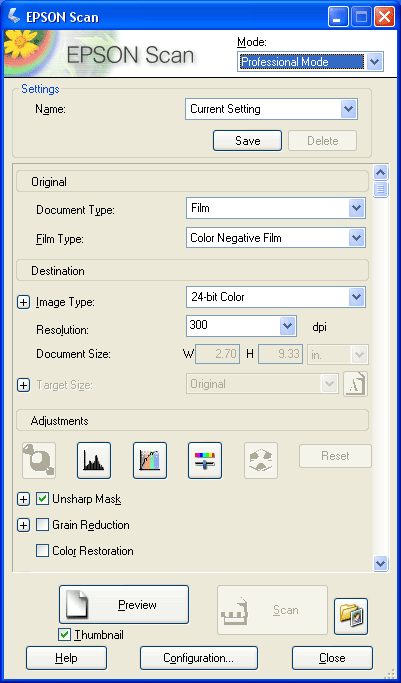
Before you scan your film or slides, you need to select these basic settings.
Original settings. These tell Epson Scan the type of film or slides you are scanning.
Destination settings. These tell Epson Scan how you plan to use your scanned images.
Follow these steps to select the basic settings for film or slides in Epson Scan.
 | Do one of the following to select your document type. |
Home mode:
Click the arrow to open the Document Type list and select the type of film or slide(s) you are scanning. Select Color Negative Film, B&W Negative Film, or Positive Film for a film strip, or Positive Film for slides. Then click the Color, Grayscale, or Black&White button to match the colors in the original, if necessary.
Professional mode:
Click the arrow to open the Document Type list and select Film (for scanning film or slides). Then click the arrow in the Film Type list and select Color Negative Film, B&W Negative Film, or Positive Film for a film strip, or Positive Film for slides.
 | Do one of the following to select your destination setting(s). |
Home mode:
In the Destination box, click the button for the way you plan to use the scanned images.
Screen/Web for images you will view only on a computer screen or post on the web.
Printer for images you will be printing.
Other if you want to select a specific resolution for other purposes.
Professional mode:
Click the arrow to open the Image Type list and select the image type you are scanning.
| Image Type setting | Type of image you are scanning |
| 48-bit Color | Color photo that you may want to modify in a 48-bit image-editing program |
| 24-bit Color | Color photo |
| Color Smoothing | Color graphics, such as a chart or graph |
| 16-bit Grayscale | Black-and-white photo with many shades of gray |
| 8-bit Grayscale | Black-and-white photo with just a few shades of gray |
| Black & White | Black-and-white positive film or slides |
 | In Home Mode, Epson Scan selects a default resolution setting based on the Destination setting you select. See Selecting the Scan Resolution to continue scanning. |
Selecting the Scan Resolution
In Home Mode, you can change the resolution only if you select Other as the Destination setting.

In Professional Mode, you can select the resolution you want at any time.

Before you select the scan resolution, you should consider whether you will enlarge your images before or after you scan them. Follow these guidelines.
You will not be enlarging the images.
If you will scan the images at 100% size or smaller and will not enlarge them later, you can accept the Resolution setting selected by Epson Scan based on your Destination setting (Home Mode only).
You will enlarge the images as you scan them (increase the Target Size setting).
If you will enlarge the images in Epson Scan so you can use them at a larger size, you can accept the Resolution setting selected by Epson Scan based on your Destination setting (Home Mode only).
You will scan the images at their original size, but then enlarge them later in an image-editing program.
If you plan to enlarge your images later in an image-editing program, you need to increase the Resolution setting to retain a high image quality after enlargement. Increase the resolution by the same amount you will increase the image size. For example, if the resolution is 300 dpi (dots per inch), but you will increase the image size to 200% in an image-editing program, change the Resolution setting to 600 dpi in Epson Scan.
Click the arrow next to the Resolution list and select the number of dots per inch at which you want to scan. See the table below for some guidelines.
| What you will do with the scanned image | Suggested scan resolution |
| Send via e-mail, upload to web, view only on the screen | 96 to 150 dpi |
| | 300 dpi |
| Fax | 200 dpi |
| Enlarge after scanning at 100% | Increase Resolution setting by same amount you will increase image size after scanning |
After selecting the Resolution, you can preview your images and make any necessary adjustments. See Previewing and Adjusting the Scan Area to continue scanning.
Previewing and Adjusting the Scan Area
Once you have selected your basic settings and resolution in Home or Professional Mode, you can preview your images and select or adjust the area of the images you want to scan. Epson Scan displays the preview images in a separate Preview window on your screen.
There are two types of preview.
Normal preview displays your previewed images in their entirety. You must select the scan area and make any image quality adjustments manually.
Thumbnail preview displays your previewed images as thumbnails. Epson Scan automatically locates the edges of your scan area and applies automatic exposure settings to the images. This is the default preview type when scanning film or slides.
 Note:
Note:
If you are scanning negative slides, you must use the normal preview.
Follow these steps to preview your images in Home or Professional Mode.
 | Click the Preview button toward the bottom of the Epson Scan window. If you want to change the preview type, click the Thumbnail checkbox under the Preview button, if it is available. |

Epson Scan prescans your images and displays them in one of the following Preview windows.

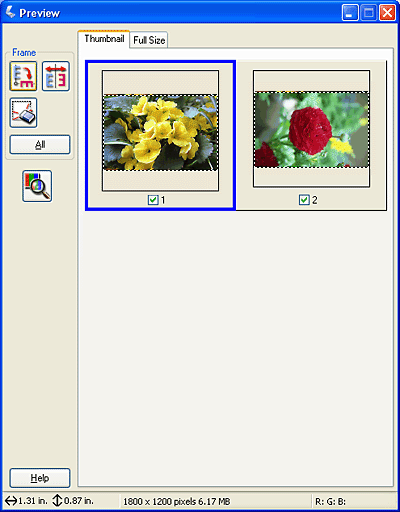
 | If you are viewing the normal preview, you can do the following to adjust the image(s). |
To select your scan area, draw a marquee that marks the edges of the scan area on each image. You can move and resize the marquees to change the scan areas as necessary. See Adjusting the Scan Area (Marquee) for instructions.
 Note:
Note:
If you are going to scan at a different size than your original, you must first select your Target Size and automatically create a marquee that is proportioned to that size. See Selecting the Scan Size for instructions. You can then copy the marquee and place it on each image you will scan at that size.
To zoom in on an image, click inside the scan area and click the Zoom button. Epson Scan prescans again and displays a larger preview on the Zoom tab. (Your other images are still previewed at the original size on the Preview tab.)
 | If you are viewing the thumbnail preview, you can do the following to adjust the image(s). |
To zoom in on an image, double-click its thumbnail, or click the thumbnail and then click the Full Size tab near the top of the Preview window. (This feature is only available when you are scanning multiple images at the same time.)
To rotate an image or flip it horizontally (like a mirror image), click its thumbnail and then click the  rotation icon or
rotation icon or  mirroring icon.
mirroring icon.
To adjust the scan area to crop your image, you can create and move a marquee that marks the edges of your scan. See Adjusting the Scan Area (Marquee) for instructions.
To adjust the image quality, click the image(s) you want to modify and make the adjustments as described in Adjusting the Color and Other Image Settings. If you want to apply the adjustments to all your images, click the All button.
 Note:
Note:
 | When you have finished adjusting the scan areas, and modifying the color and image settings, you can select the size of your scanned image, if you have not already selected it. See Selecting the Scan Size for instructions. |
Adjusting the Scan Area (Marquee)
A marquee is a moving dotted line that appears on the edges of your preview image to indicate the scan area.

You can move the marquee, adjust its size, and create multiple marquees on one image (normal preview only) to scan different image areas in separate scan files. Follow these steps.
 Note for Home Mode users:
Note for Home Mode users:
When you use the Thumbnail preview with film or slides, Epson Scan automatically creates marquees around your image(s) for you. If you need to adjust a marquee, click inside it and click the  delete marquee icon before completing the steps in this section. If you do not need to adjust any marquees, skip to Adjusting the Color and Other Image Settings.
delete marquee icon before completing the steps in this section. If you do not need to adjust any marquees, skip to Adjusting the Color and Other Image Settings.
 | To draw a marquee, move your cursor over a preview image. The pointer becomes a set of cross-hairs. |
 | Position the pointer in the area where you want to place the corner of your marquee and click. Hold down the mouse button and drag the cross-hairs over the image to the opposite corner of the desired scan area. Then release the mouse button. You see the moving dotted line of the marquee. |

 | Do one of the following to adjust the marquee. |
To move the marquee, position your cursor inside the marquee. The pointer becomes a hand. Click and drag the marquee to the desired location.

To resize the marquee, position your cursor over the edge or corner of the marquee. The pointer becomes a straight or angled double-arrow. Click and drag the edge or corner to the desired size.

 Note:
Note:
To restrict movement of the marquee to vertical or horizontal only, hold down the Shift key as you move the marquee. To restrict sizing of the marquee to the current proportions, hold down the Shift key as you resize the marquee.
For best results and image exposure, make sure all sides of the marquee are located inside the preview image. Do not include any of the area around the preview image in the marquee.
 Note:
Note:
If you draw multiple marquees, make sure you click the All button in the Preview window before you scan; otherwise, only the area inside of the last marquee you drew will be scanned.
If you are scanning multiple slides or images in a film strip using the Normal preview, you must draw a separate marquee over each image in order to scan the images as separate files.
Adjusting the Color and Other Image Settings
Once you have previewed your images and adjusted the scan area, you can modify the image quality, if necessary. Epson Scan offers a variety of settings for improving color, sharpness, contrast, and other aspects affecting image quality.
Before you make adjustments, be sure to click the image or marquee for the area you want to adjust. In Professional Mode, you may need to scroll down to the Adjustments area of the main Epson Scan window.

The table below describes the settings available in Home and/or Professional Mode. For details on adjusting these settings, click Help in the Epson Scan window.
When you are finished making adjustments, you can size your scanned images (see Selecting the Scan Size) or go ahead and scan (see Finishing the Scan).
| Setting | Available mode(s) and description |
| Color Restoration | Home and Professional: |
| Dust Removal | Professional only: |
| Backlight Correction | Home and Professional: |
| Grain Reduction | Professional only: |
| Digital ICE Technology and Digital ICE Lite Technology | Home and Professional: |
| Brightness | Home and Professional: In Home Mode, click the Brightness button to access the Brightness setting. In Professional Mode, click the |
| Contrast | Home and Professional: In Home Mode, click the Brightness button to access the Contrast setting. In Professional Mode, click the |
| Saturation | Professional only: Click the |
| Color Balance | Professional only: Click the |
| Auto Exposure | Home: Automatically applied. Professional: Automatically applied. To adjust the level of exposure, click the Configuration button, click the Color tab, and adjust the Auto Exposure Level slider. If you don't want Auto Exposure automatically applied, deselect Continuous Auto Exposure in the Color tab. Then, click the |
| Unsharp Mask | Home: Automatically applied. Professional: Turned on by default. Unsharp Mask makes the edges of image areas clearer for an overall sharper image. The level of sharpness is adjustable. Turn off to leave softer edges. |
| Histogram | Professional only: Click the |
| Tone Correction | Professional only: Click the |
| Color Palette | Professional only: Click the |
| Threshold | Home and Professional: In Home Mode, click the Brightness button to access the Threshold setting. |
 Note:
Note:
To view the red, green, and blue levels at particular points in your preview image as you make adjustments, click the  densitometer icon in the preview window and click an image area. See Epson Scan help for details.
densitometer icon in the preview window and click an image area. See Epson Scan help for details.
Certain settings may not be available, or may be automatically selected, depending on the type of image you are previewing and other settings you have selected.
You can customize how certain Epson Scan settings behave by clicking the Configuration button and changing settings in the window that appears. See Epson Scan Help for details.
To undo any image quality adjustments you make to the preview image, click the Reset button (if available), turn off the setting, or preview your image again.
Selecting the Scan Size
You can scan your images at their original size, or you can reduce or enlarge their size as you scan them. You do this using the Target Size setting in Home or Professional Mode.
Home Mode

Professional Mode

If you are going to scan your image to a particular size, you should select the Target Size setting after previewing it, but before adjusting your scan area (indicated by the marquee). This sets the scan area to the correct proportions so your image will not be cropped unexpectedly.
For instructions on previewing your images, see Previewing and Adjusting the Scan Area. Then follow these steps to select the Target Size setting.
 Note for Home Mode users:
Note for Home Mode users:
When you use the Thumbnail preview with film or slides, Epson Scan automatically selects a target size of 4 × 6 in. for you. If you need to select a different target size, complete all of the steps in this section. If you do not need to adjust any target sizes, go to step 5.
 | You can choose a predefined scan size from the Target Size list. Click the arrow in the list and select the size you want. A marquee (dotted line) proportioned for that size appears on your preview image. |

 | If you need to create a scan size that is not in the Target Size list, you can create a custom size. Click the arrow in the list and select Customize. You see the Target Size window. |

Type a name for your custom size, enter the size, click the Save button, then click OK. Your new size appears in the Target Size list.
 | In Professional Mode, you can fine-tune the size using additional tools. Click the + (Windows) or |

To size your image by a certain percentage, adjust the Scale value.
To change the way your image is cropped, turn Trimming on or off. (See Epson Scan Help for details.)
To unlock the proportions of your scan size, click the  lock icon. Then adjust the marquee or enter new width/height measurements.
lock icon. Then adjust the marquee or enter new width/height measurements.
 | Once you have selected your scan size, you can click and drag the marquee to the area in the image you want to scan. For details, see Adjusting the Scan Area (Marquee). The marquee proportions are retained as you adjust it. |
If you need to rotate the marquee for a landscape or portrait image without changing its aspect ratio, click the  orientation icon. (Not available if you are scanning at the Original Target Size.)
orientation icon. (Not available if you are scanning at the Original Target Size.)
 Note:
Note:
For more information about using the Target Size tools, click Help in the Epson Scan window.
 | Now you are ready to scan your images. Click the Scan button, and see Finishing the Scan for instructions. |
Finishing the Scan
What happens after you scan depends on how you started your scan.
If you started your scan by pressing the  Start button or running Epson Scan as a standalone program and you used Full Auto Mode, your scanned image is saved in the file format and location you chose. If you did not choose any file save settings, it is saved as a JPEG file in the Pictures or My Pictures folder.
Start button or running Epson Scan as a standalone program and you used Full Auto Mode, your scanned image is saved in the file format and location you chose. If you did not choose any file save settings, it is saved as a JPEG file in the Pictures or My Pictures folder.
If you started your scan by pressing the  Start button or running Epson Scan as a standalone program and you used Home or Professional Mode, you see the File Save Settings window. This lets you select the name and location of your saved scan files. See Selecting File Save Settings for details.
Start button or running Epson Scan as a standalone program and you used Home or Professional Mode, you see the File Save Settings window. This lets you select the name and location of your saved scan files. See Selecting File Save Settings for details.
If you started your scan from a scanning program such as Adobe Photoshop Elements, your scanned images open in the program window. If Epson Scan does not automatically close after scanning, click Close to close the Epson Scan window and view your images in the program.
beasleyspladebeforn.blogspot.com
Source: https://files.support.epson.com/htmldocs/prv5ph/prv5phug/scan2_4.htm
 Image Adjustment button to access the Brightness setting.
Image Adjustment button to access the Brightness setting. Auto Exposure button (Professional Mode only) or reselect Continuous Auto Exposure whenever you want to apply this setting to an image.
Auto Exposure button (Professional Mode only) or reselect Continuous Auto Exposure whenever you want to apply this setting to an image. Histogram Adjustment button to access the Histogram setting.
Histogram Adjustment button to access the Histogram setting. Tone Correction button to access the Tone Correction setting.
Tone Correction button to access the Tone Correction setting. Color Palette button to use the Color Palette settings. See Using the Color Palette Function (Professional Mode Only) for instructions.
Color Palette button to use the Color Palette settings. See Using the Color Palette Function (Professional Mode Only) for instructions. (Mac OS X) next to Target Size to display these tools.
(Mac OS X) next to Target Size to display these tools.
0 Response to "How Come the Epson V750 Pro Wont Scan Continuously Without Me Moving the Mouse"
Post a Comment